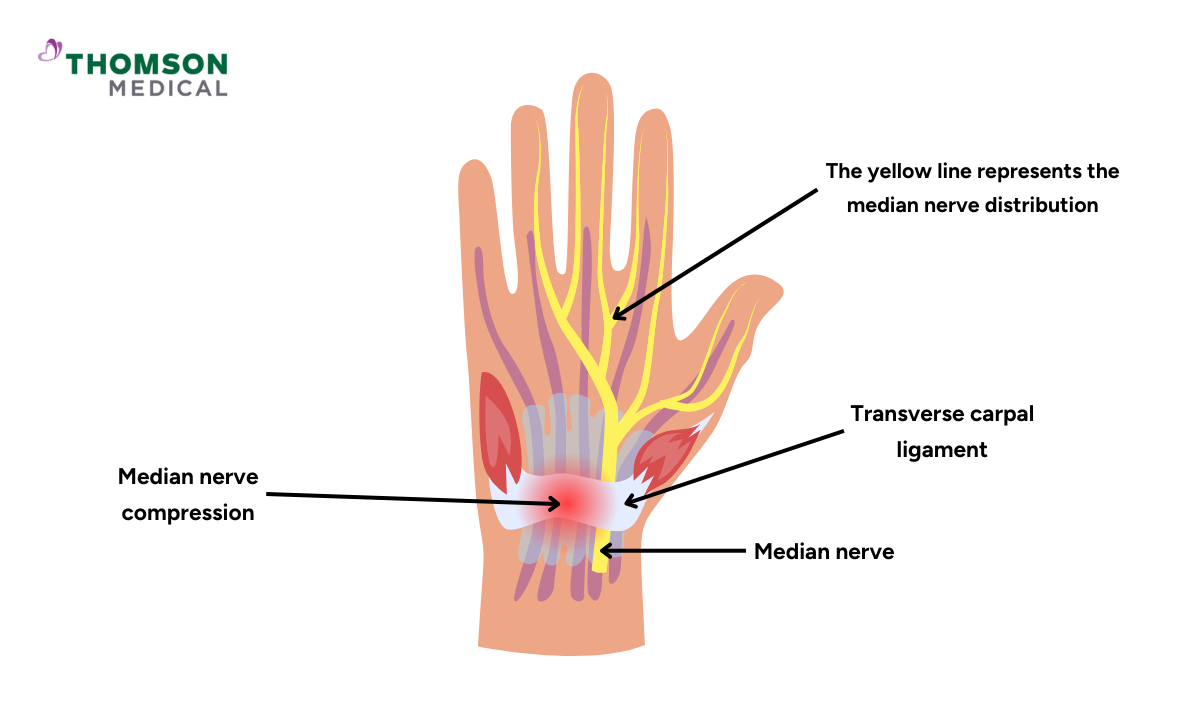What is the Phalen's test?
The Phalen test, also known as Phalen's sign or manoeuvre, is a specific wrist movement used in the diagnosis of carpal tunnel syndrome. During the test, your healthcare provider will ask you to bend your wrists and hold them in a position that puts light pressure on the median nerve inside the carpal tunnel.
If you experience symptoms of carpal tunnel syndrome in your fingers or palm during the test, this may indicate that you have the condition. This simple physical exam can be performed without any special equipment.
When would I need the Phalen's test?

Your healthcare provider may recommend this test if you experience symptoms like wrist pain, tingling, numbness, or weakness. These symptoms can be triggered by prolonged use of your wrists, for example, after a long session of typing or using tools.
The condition typically affects the median nerve distribution region, which includes the thumb, index finger, middle finger, and palm.
The aim of the test is to reproduce the symptoms and assess whether there is extra pressure on the median nerve running through your carpal tunnel, which could be irritating it. The Phalen's test allows your healthcare provider to confirm that your condition is indeed caused by carpal tunnel syndrome.
If you are experiencing any of the mentioned symptoms, request an appointment with Thomson Medical. Our specialists can assist with further diagnosis, including a Phalen’s test to determine the underlying cause of your symptoms and provide a tailored treatment plan.
How do I prepare for the Phalen's test?
The Phalen's test is a simple procedure that does not require any special preparation. However, if you have any pre-existing conditions affecting your hands or wrists, make sure you inform your healthcare provider beforehand.
This will enable them to properly assess your condition first and ensure that the test is safe for you. To obtain the most accurate results, it is also helpful if your hands and wrists are free from recent injuries.
How is the Phalen's test performed?
As part of the assessment for carpal tunnel syndrome, your healthcare provider will examine your wrists, hands, and fingers first. They'll ask about your symptoms, when you first noticed them, if any activities worsen them, and if you feel any pain.
Following the initial examination, your healthcare provider may ask you to perform the Phalen's test or the reverse Phalen's test to further assess your condition. They will demonstrate the correct positioning for your arms, hands and wrists and supervise you while you hold these positions.
Try to follow their instructions and maintain the positions for as long as directed. As this evaluation of carpal tunnel puts light pressure on it, you may experience some discomfort or a tingling sensation, but you should not experience intense pain. If you do, tell your healthcare provider immediately.
Phalen's test

You can expect the following instructions from a doctor as they walk you through the test:
With your hands at around waist height, you will be instructed to place the backs of your hands together in front of you with your fingers pointing downwards to form an upside-down "praying hands" position.
While holding your hands in that position, raise your arms until your elbows are approximately at chest level.
Maintain this position for about 60 seconds, or until you experience symptoms such as numbness, tingling, or pain.
Reverse Phalen’s test

Additionally, your healthcare provider may also ask you to perform the reverse Phalen's test. Here's what happens during the test:
With your hands at chest height, place your hands and wrists together in a 'prayer' position, pointing your fingers upwards and bending your wrists back (extending them).
Keeping your elbows in place, you’ll lower your hands toward your stomach.
Hold this position for up to 2 minutes.
What do the results mean?
A positive result on both the Phalen test and the reverse Phalen test indicates carpal compression affecting the region of the median nerve distribution. This can result in carpal tunnel syndrome symptoms such as burning, tingling or numbness.
If no symptoms occur, carpal tunnel syndrome is less likely. However, your healthcare provider may recommend an imaging test, such as an MRI scan or ultrasound, to confirm the diagnosis or identify any irritation in your wrist.
If you would like more information about Phalen's tests, request an appointmentwith Thomson Medical. Our specialists can help explain this procedure to you in more detail and determine if it suits your medical condition.
Are there any risks?
The Phalen's test is generally considered safe with no significant risks. However, if you already have carpal tunnel syndrome, making your wrists flex during the test may cause temporary discomfort, tingling, or numbness.
Sharp or intense pain is not expected, and the test should be stopped if it occurs. Most symptoms brought on by the Phalen's test will resolve shortly after it is finished.
If you experience significant pain or your symptoms worsen during the test, inform your healthcare provider immediately.
FAQ
Can you perform a Phalen test at home?
Yes, you can perform the Phalen's test at home by placing the backs of your hands together and bending your wrists for around one minute. However, it is best to do this under the guidance of a healthcare professional.
If you experience tingling or numbness in your fingers while doing the test, you should visit your doctor for a proper diagnosis and advice on what to do next.
What are the signs of a positive Phalen's test?
A positive Phalen's test usually results in tingling, numbness or pain in the thumb, index finger, middle finger, or part of the ring finger. These symptoms of carpal tunnel suggest compression of the median nerve, which is a common sign of carpal tunnel syndrome.
How long does the Phalen’s test take?
The Phalen's test is typically performed for up to 60 seconds. If symptoms such as tingling or pain occur before this time, the test is still considered positive.
How is carpal tunnel syndrome confirmed?
Your healthcare providers will typically use a combination of the following methods to confirm carpal tunnel syndrome:
Physical exam:
Phalen's test involves holding the wrists in a flexed position to see if symptoms appear.
Tinel's sign involves tapping over the median nerve at the wrist to check for tingling or a shock-like sensation, which can indicate nerve irritation.
Durkan's compression test involves applying direct pressure over the carpal tunnel to see if symptoms are reproduced.
Medical history:
A detailed account of symptoms such as tingling, numbness and pain in the fingers, particularly the thumb, index finger and middle finger, will help guide the diagnosis.
Your doctor will ask about activities that may exacerbate symptoms, such as repetitive wrist movements (e.g. typing or working on an assembly line).
Nerve conduction studies (NCS):
This is one of the most reliable diagnostic tools for carpal tunnel. It measures how well electrical impulses travel along the median nerve.
If conduction is slow or impaired, this indicates compression of the median nerve in the carpal tunnel.
Electromyography (EMG):
This test evaluates the electrical activity of muscles. It helps to determine whether muscle weakness or numbness is due to nerve damage, and if so, whether it is from the median nerve or another cause.
Ultrasound or MRI:
In some cases, ultrasound or MRI scans may be used to visualise the carpal tunnel and its surrounding structures, checking for conditions that might contribute to the syndrome, such as swelling or anatomical abnormalities.
What are the red flags for carpal tunnel syndrome?
Red flags for carpal tunnel syndrome include:
Severe, constant pain in the hand, wrist or arm that does not improve with rest
Worsening numbness or tingling that spreads beyond the thumb, index finger, and middle finger.
Muscle weakness in the hand or difficulty gripping objects.
Atrophy (shrinking) of the muscles at the base of the thumb.
Is the Phalen’s test accurate?
The Phalen's test is a useful screening tool, but it is not conclusive on its own. While it can suggest the presence of carpal tunnel syndrome, further tests, such as nerve conduction studies, are often required to confirm the diagnosis and rule out other conditions.
The information provided is intended for general guidance only and should not be considered medical advice. For personalised recommendations and tailored advice, please consult a specialist at Thomson Medical. Request an appointment with Thomson Medical today.
For more information, contact us:
Thomson Specialists Paragon (Health Screening)
- Mon - Fri: 8.30am - 5.30pm
- Sat: 8.30am - 12.30pm
Call: 6735 0300
See Health Screening Packages
Notice:
The range of services and tests may vary. Please contact us directly to enquire about the current availability.
Book Health Screening